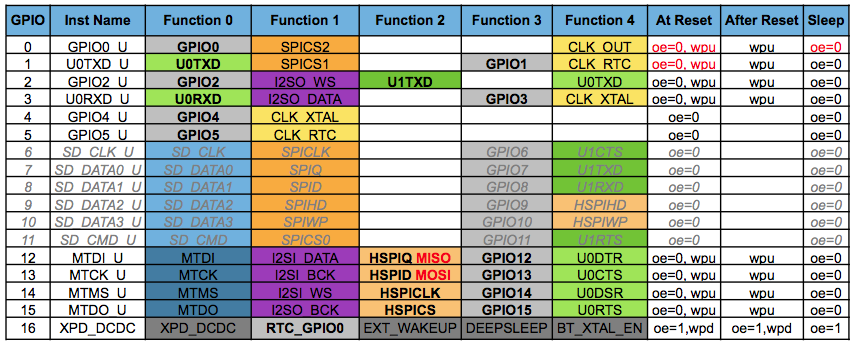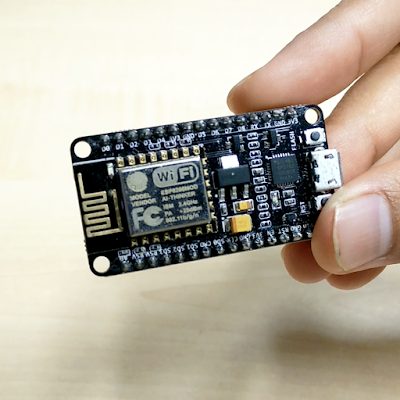NodeMCU V2 also known as NodeMCU v1.0 is the 2nd revision of NodeMCU series. This WiFi Internet of Things (IOT) module is compatible with Arduino IDE. The default mod for this ESP8266 ESP-12E chip is Ai-Thinker firmware. One of the main different between NodeMCU V1 and NodeMCU V2 is the chip was upgraded from ESP-12 to ESP-12E. The board in this version also become narrower compare as before which is a bit wider.
ESP8266 is high integration wireless SOCs, designed for space and power constrained mobile platform designers. It provides unsurpassed ability to embed Wi-Fi capabilities within other systems, or to function as a standalone application, with the lowest cost, and minimal space requirement.
The default baudrate for this NodeMCU V2 firmware is 9600 as shown in figure below.
 |
| Back view of NodeMCU V2 / NodeMCU v1.0 |
 |
| Top view of NodeMCU V2 / NodeMCU v1.0 |
The main reason of this revision become narrower is to allow the board fixed nicely into a breadboard. There are still one row of breadboard left after NodeMCU V2 being stacked. This extra row allow wire jumpers to be connected using a single breadboard only.
Alternately, serving as a Wi-Fi adapter, wireless internet access can be added to any micro controllerbased design with simple connectivity (SPI/SDIO or I2C/UART interface). ESP8266EX is among the most integrated WiFi chip in the industry; it integrates the antenna switches, RF balun, power amplifier, low noise receive amplifier, filters, power management modules, it requires minimal external circuitry and the entire solution, including front-end module, is designed to occupy minimal PCB area.
 |
| NodeMCU V2 / NodeMCU v1.0 Pins |
 |
| NodeMCU V2 / NodeMCU v1.0 Pinout (Board view) |
Table below shows the standard GPIO table for ESP8266. Both ESP-12 and ESP-12E is quite similar but somehow there is an extra of 6 GPIO pins in ESP-12E. This ESP-12E (ESP8266EX) is embedded with an enhanced version of Tensilica L106 Diamond series 32-bit micro controller (MCU) which features extra low power consumption and 16-bit RSIC. The CPU clock speed is 80MHz which also can reach a maximum value of 160MHz. ESP-12E is often integrated with external sensors and other specific devices through its GPIO.
ESP8266EX WiFi SoC is embedded with memory controller, including SRAM and ROM. MCU can visit the memory units through iBus, dBus, and AHB interfaces. All memory units can be visited upon request, while a memory arbiter will decide the running sequence according to the time when these requests are received by the processor.
This module is mounted with an 4 MB external SPI flash to store user programs. If larger definable storage space is required, a SPI flash with larger memory size is preferred. Theoretically speaking, up to 16 MB memory capacity can be supported.
 |
| ESP8266 GPIO Table |
Below is an overview video of NodeMCU V2.
Overview of NodeMCU V2 ESP8266 Arduino IDE Compatible
Features:
The wireless SoC has the following:
802.11 b/g/n protocol
Wi-Fi 2.4 GHz, support WPA/WPA2
Integrated 10-bit ADC
Integrated TCP/IP protocol stack -ipv4 only at the moment
Integrated TR switch, balun, LNA, power amplifier and matching network Integrated PLL, regulators, and power management units
+20dBm output power in 802.11b mode
Supports antenna diversity
Integrated low power 32-bit MCU
The 32-bit MCU has the following:
GPIO, I2C, ADC, SPI, PWM and many more
Running at 80MHz
64KBytes of instruction RAM
96KBytes of data RAM
64KBytes boot ROM
4MB of flash
RISC architecture






"• Nice and good article. It is very useful for me to learn and understand easily. Thanks for sharing your valuable information and time. Please keep updating IOT Online Training
ReplyDelete"
Hi Maker Stream.
ReplyDeleteI would like to ask permission to use this picture on my personal website. Im writing about my own projects revolving Home assistant and electronic, and need a few pictures to illustrate. It is non-commercial.
Hmm, my comment was stripped. Anyway it was the top-view of the mcu picture I would be thankful for to be allowed to use. If not that's ok too.
ReplyDelete